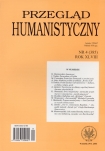AKADEMIA KIJOWSKO-MOHYLAŃSKA: HISTORIA I WSPÓŁCZESNOŚĆ
KIEV-MOHYLAN ACADEMY: HISTORY AND THE PRESENT
Author(s): Teresa Chynczewska-HennelSubject(s): Cultural history
Published by: Wydawnictwa Uniwersytetu Warszawskiego
Keywords: Kiev; Mohyle; university
Summary/Abstract: Kiev-Mohylan Academy called after its founder, Russian Orthodox metropolitan Piotr Mohyla (1596-1647), was crucial for culture and religion in Polish Republic and Ukraine. It influenced other countries “from Moscow to far Siberia”, as well as southern Europe. Intellectual and military elite of Orthodox Russia was associated with the Academy. Although its nature was Russian Orthodox, it was based on Jesuit and west European patterns. It combined Russian Orthodox elements and western culture. Greek, Old-Slavonic, Latin and Polish were taught there. However, it had a guaranteed status of academy only by the Hadiatch Treaty and later by Peter I. It was closed down in 1817. It reappeared as the National University a year after Ukraine had regained its independence on 24 August 1992. The school accepts students at the following faculties: Arts, Economy, Biology, Law, Computer Studies and Sociology. The teaching process is based on the principle of “Liberal arts education”.
Journal: Przegląd Humanistyczny
- Issue Year: 404/2006
- Issue No: 01
- Page Range: 59-68
- Page Count: 10
- Language: Polish
- Content File-PDF

